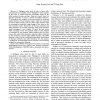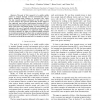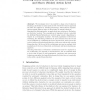265 search results - page 42 / 53 » Learning to Drive and Simulate Autonomous Mobile Robots |
HRI
2006
ACM
14 years 1 months ago
2006
ACM
Autonomous robots use sensors to perceive and track objects in the world. Tracking algorithms use object motion models to estimate the position of a moving object. Tracking effic...
ICRA
2009
IEEE
13 years 5 months ago
2009
IEEE
A Skilligent robot must be able to learn skills autonomously to accomplish a task. "Skilligence" is the capacity of the robot to control behaviors reasonably, based on th...
NN
2007
Springer
13 years 7 months ago
2007
Springer
Several scientists suggested that certain perceptual qualities are based on sensorimotor anticipation: for example, the softness of a sponge is perceived by anticipating the sensa...
ICRA
2010
IEEE
13 years 6 months ago
2010
IEEE
— The goal of this research is to enable mobile robots to navigate through crowded environments such as indoor shopping malls, airports, or downtown side walks. The key research ...
IWINAC
2007
Springer
14 years 1 months ago
2007
Springer
We investigate how it is possible to shape robot behaviour adopting a molecular or molar point of view. These two ways to approach the issue are inspired by Learning Psychology, wh...



